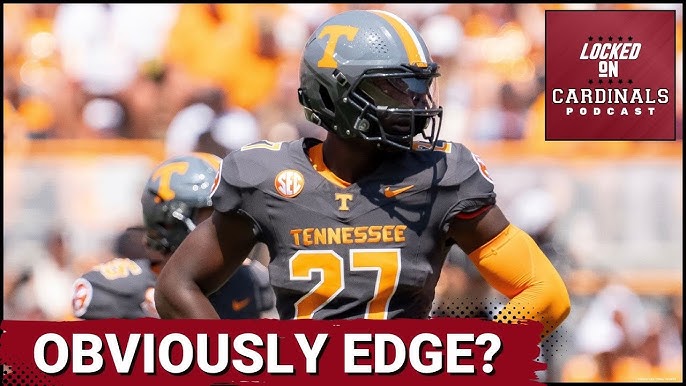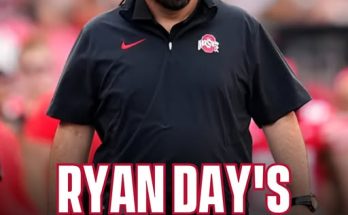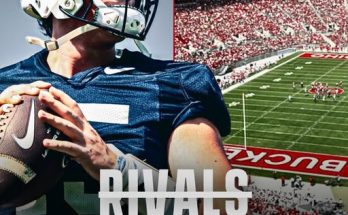The Arizona Cardinals find themselves in an intriguing position heading into the 2025 NFL Draft. Armed with two first-round picks — including the coveted No. 4 overall selection — the team has a rare opportunity to reshape its roster in a significant way. With franchise quarterback Kyler Murray back healthy and a new era under head coach Jonathan Gannon continuing to take form, the Cardinals are building toward contention. However, one of the most debated decisions facing the front office revolves around their second first-rounder, pick No. 16 overall. Many draft analysts and fans alike have penciled in an EDGE rusher at that spot, but that decision may not be as cut-and-dried as it seems.
On the surface, the rationale makes sense. Arizona’s pass rush in 2024 left much to be desired. The team finished in the bottom half of the league in sacks, pressure rate, and quarterback knockdowns. The retirement of J.J. Watt the year prior left a leadership void, and while second-year linebacker BJ Ojulari showed flashes, the team lacks a dominant force on the edge. Naturally, using the 16th overall pick to bolster that weakness seems logical.
But logic can be deceiving when it’s not paired with context. The Cardinals’ roster holes go beyond just the edge rush, and the value of available EDGE prospects at No. 16 may not match the urgency some are attaching to the position. What’s more, in a class that is loaded at wide receiver, offensive tackle, and cornerback — all areas of need for Arizona — the smart play may be to pivot away from the perceived “need” and invest in a position with stronger value or greater long-term impact.
For starters, it’s worth acknowledging the sheer unpredictability of drafting EDGE defenders outside the top 10. While the position itself is critical in today’s pass-happy NFL, history tells us that true game-wreckers off the edge are generally off the board early. By the time the Cardinals are on the clock at No. 16, prospects like Alabama’s Dallas Turner, Florida State’s Jared Verse, and UCLA’s Laiatu Latu could very well be gone. What’s left may be talented, but is less of a sure thing — think traits-based prospects with high ceilings but questionable floors.
Arizona has already dipped into that well with Ojulari in 2023 and Cam Thomas the year before. Both have promise, but the team needs more certainty at this point in the rebuild. Reaching for a mid-first-round EDGE who may not be markedly better than someone they could land in the second round or even via trade seems shortsighted.
Adding to that concern is the reality that Arizona’s defensive scheme under Gannon doesn’t necessarily demand a traditional, hand-in-the-dirt EDGE presence. The team often rotates its fronts, employing a blend of 3-4 and 4-3 principles. That means pass rush can be generated from multiple spots, including blitzing linebackers, interior linemen, and even disguised safety looks. In Philadelphia, Gannon had elite depth across the front, but his system relied more on versatility than having one dominant rusher. In Arizona, where depth is still building, it might be smarter to prioritize flexible pieces who can create mismatches — not just edge specialists.
Then there’s the draft class itself. The 2025 group is particularly strong at wide receiver, with as many as seven potential first-rounders offering game-breaking speed, size, or route-running. Arizona could pair a new weapon with Kyler Murray and Marvin Harrison Jr. (assuming he’s the pick at No. 4) to completely revamp its offense. A trio of Harrison, a second dynamic receiver, and tight end Trey McBride could quickly become one of the NFL’s most potent young pass-catching groups. With offensive coordinator Drew Petzing looking to implement a more vertical attack, a second receiver might be a higher-impact addition than another developmental pass rusher.
The same logic applies to the offensive line, particularly at tackle. D.J. Humphries’ release and Paris Johnson Jr.’s move to left tackle leaves a hole on the right side. If a player like Georgia’s Amarius Mims or Oklahoma’s Tyler Guyton falls to 16, the Cardinals could shore up both ends of their line and protect Murray for the long haul. Given the franchise’s recent history of quarterback injuries, that could be the most valuable investment of all.
And let’s not forget about the secondary. Arizona’s defensive backs had a rough go last season, especially at corner. With divisional opponents like the Rams and 49ers possessing high-octane passing games, the need for a lockdown cornerback is real. This year’s draft includes top-tier options like Clemson’s Nate Wiggins, Alabama’s Kool-Aid McKinstry, and Iowa’s Cooper DeJean — all potential Day 1 starters who could be available at No. 16. In a passing league, the ability to cover is nearly as important as the ability to pressure the quarterback.
Beyond roster needs and positional value, there’s also the broader strategy to consider. General manager Monti Ossenfort has made it clear he wants to build this team patiently, sustainably, and with a high floor. That means minimizing risk, maximizing return, and stacking assets. Taking a swing on a mid-round EDGE, especially in a class that lacks consensus after the top two or three, runs counter to that approach. If the Cardinals aren’t in love with the remaining edge rushers on the board, they could easily trade back, pick up additional draft capital, and target value in the late first or early second round.
It’s also worth considering the landscape of free agency and the trade market. The NFL has seen an increasing number of pass rushers become available via trade — whether it’s disgruntled veterans looking for new contracts or cap casualties looking for fresh starts. The Cardinals could take advantage of that reality and pursue an established presence without using a premium pick on a position known for its boom-or-bust rate.
None of this is to say Arizona should completely avoid adding help on the edge. It’s a crucial position, and the team needs more juice off the line. But not all roster needs are created equal, and not all draft classes present the same solutions. Taking an EDGE at 16 just because it feels like the obvious fix could lead to long-term disappointment, especially if it means passing on more impactful or reliable options.
The Cardinals are at a crossroads — but it’s a promising one. With flexibility, draft capital, and a franchise quarterback in place, this team has the tools to build a contender. The key is not falling into the trap of drafting for need instead of drafting for value. The No. 16 pick is a chance to add a foundational piece, not just a bandaid for a specific flaw.
Arizona’s best move might be the one that goes against the grain. Think twice about EDGE at 16. Think big picture instead.



